Topic: Properties Identification And Use Of Minerals
Properties Identification And Use Of Minerals
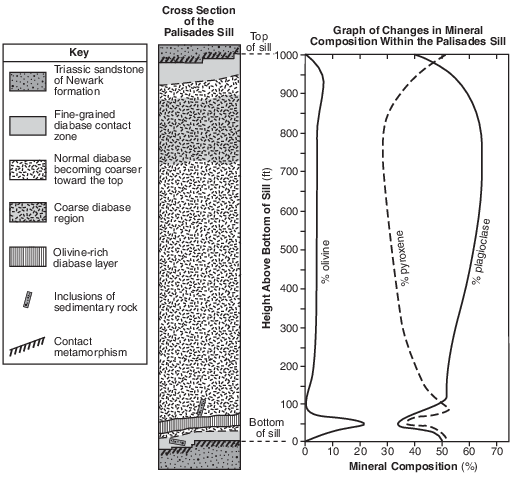
Which two minerals, not shown on the Graph of Changes in Mineral Composition Within the Palisades Sill, are also likely to be found in some other samples of diabase?
(1) amphibole and potassium feldspar
(2) potassium feldspar and quartz
(3) quartz and biotite
(4) biotite and amphibole
The element silicon (Si) is used in the production of cell phones. Which mineral could be a possible source of this silicon?
(1) calcite
(2) galena
(3) halite
(4) quartz
What is the approximate density of a mineral with a mass of 262.2 grams that displaces 46 cubic centimeters of water?
(1) 1.8 g/cm3
(2) 5.7 g/cm3
(3) 6.1 g/cm3
(4) 12.2 g/cm3
Which two properties are most useful in distinguishing between galena and halite?
(1) cleavage and color
(2) luster and color
(3) hardness and streak
(4) streak and cleavage
The most abundant metallic element by mass in Earth’s crust makes up 8.23% of the crust. Which group of minerals all normally contain this metallic element in their compositions?
(1) garnet, calcite, pyrite, and galena
(2) biotite mica, muscovite mica, fluorite, and halite
(3) talc, quartz, graphite, and olivine
(4) plagioclase feldspar, amphibole, pyroxene, and potassium feldspar
The diagram below represents the mass and volume of a mineral sample being measured. These measurements were used to determine the density of the mineral sample.
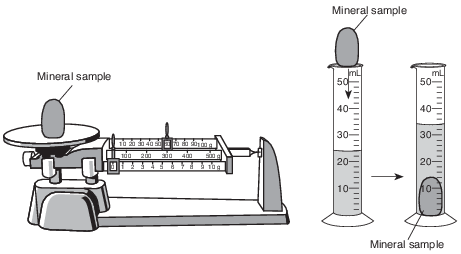
What is the density of this mineral sample?
(1) 6 g/mL
(2) 24 g/mL
(3) 34 g/mL
(4) 60 g/mL
The minerals talc, muscovite mica, quartz, and olivine are similar because they
(1) have the same hardness
(2) are the same color
(3) contain silicon and oxygen
(4) break along cleavage planes
Which rock is composed of a mineral that can be used for the production of cement?
(1) basalt
(2) limestone
(3) rock salt
(4) rock gypsum
Island Arcs
Island arcs are long, curved chains of oceanic islands associated with seismic activity and mountain-building processes at certain plate boundaries. They occur where oceanic tectonic plates collide. Along one side of these island arcs, there is usually a long, narrow deep-sea trench.
At island arcs, the denser plate is subducted and is forced into the partially molten mantle under the less dense plate. The islands are composed of the extrusive igneous rocks basalt and andesite. The basalt originates most likely from the plastic mantle. The andesite originates most likely from the melting of parts of the descending plate and sediments that had accumulated on its surface.
Which list identifies minerals present in andesite from the greatest percentage by volume to the least percentage by volume?
(1) biotite, plagioclase feldspar, amphibole
(2) biotite, amphibole, plagioclase feldspar
(3) plagioclase feldspar, biotite, amphibole
(4) plagioclase feldspar, amphibole, biotite
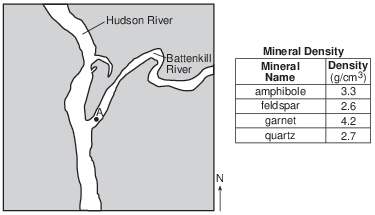
Samples of minerals listed in the mineral density table with the same shape and size were removed from the Hudson River and placed in a jar of water. After the jar was shaken, the sediments were allowed to settle. In image below, write the mineral name from the table next to the layer in the diagram where each mineral is most likely found. [1]
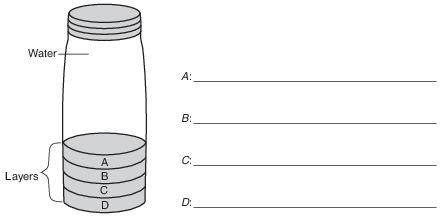
Allow 1 credit for the minerals listed in the order shown below.
• A: feldspar
• B: quartz
• C: amphibole
• D: garnet
The shaded portion on the June 21 path represents 45 degrees of the Sun’s apparent motion. Determine the number of hours that this shaded portion represents. [1]
______________ h
Allow 1 credit for 3 h or three hours.
Carrara Marble
Carrara marble is named for the town of Carrara on the west coast of Italy. This dazzling white marble has been mined since the time of the ancient Romans and remains the major industry of the area today. The marble has many commercial uses, such as tombstones, countertops, tiles, and building stones. Its chemical purity, uniform color, and hardness make this marble an ideal material for artists who carve statues from rock. Major museums around the world have statues carved from Carrara marble.
The formation of Carrara marble began 200 million years ago when a great thickness of tiny shells was deposited at the bottom of a warm, shallow sea. Over time, burial and compaction of these sediments formed sedimentary rock primarily composed of pure calcite. Approximately 27 million years ago, tectonic forces caused this area of the seafloor bedrock to be deformed and metamorphosed, forming the Carrara marble. Uplift and erosion later exposed huge formations of this famous marble.
In terms of mineral properties, explain why a statue is easier to carve from pure white marble rather than from pure white quartzite. [1]
Allow 1 credit. Acceptable responses include, but are not limited to:
• — The mineral that makes up quartzite is harder than the mineral that makes up marble.
• — The hardness of calcite is only 3 while the hardness of quartz is 7.
• — Marble is softer than quartzite because it is made of calcite, a softer mineral.
A student on a field trip in New York State collected a sample of metamorphic bedrock containing bands of coarse-grained crystals of plagioclase feldspar, pyroxene, quartz, and mica.
List two of the chemical elements found in plagioclase feldspar. [1]
(1)
(2)
Allow 1 credit for two different chemical elements. Acceptable responses include, but are not limited to:
• — Ca or calcium
• — Na or sodium
• — Al or aluminum
• — Si or silicon
• — O or oxygen
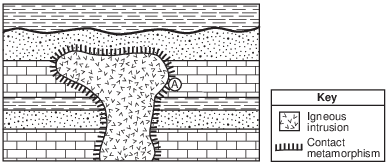
Identify one characteristic that could be used to determine if the intrusive igneous rock has a mafic composition or a felsic composition. [1]
Allow 1 credit. Acceptable responses include, but are not limited to:
• — color/light color/dark color
• — density/low density/high density
• — mineral composition
• — rich in Al, Si, or rich in Fe, Mg
• — presence/absence of quartz/potassium feldspar/pyroxene/olivine
• Note: Do not allow credit for “composition” alone because it is stated in the question.

Describe how the calcite that composes the Redwall limestone can be distinguished from the quartz that composes the Tapeats sandstone. [1]
Allow 1 credit. Acceptable responses include, but are not limited to:
• — Calcite bubbles with acid.
• — Calcite shows cleavage.
• — Quartz is harder than calcite.
• — Calcite is composed of calcium (Ca), oxygen (O), and carbon (C), and quartz is composed
• of silicon (Si) and oxygen (O).
